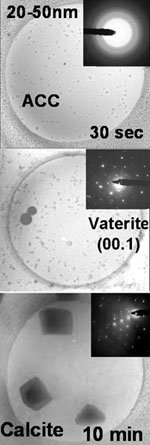Researchers in the Netherlands have produced the first real-time, three-dimensional images of the formation of calcium carbonate crystals, a robust biological mineral that holds promise as a future bone replacement material.
The scientists eventually hope to grow layers of this mineral directly onto bone replacements - such as titanium joints - building implants that aren't rejected by a patient's immune system.
Nico Sommerdijk and his colleagues at the University of Eindhoven used cryogenic transmission electron microscopy (Cryo-TEM) to take snapshots of calcium carbonate (CaCO3) crystals forming over time. He presented his results at the RSC's annual biomaterials meeting in Manchester, UK, in January.

Cryo-TEM captures crystals of calcium carbonate forming in three stages: amorphous calcium carbonate (ACC); vaterite; and (bottom) tough calcite crystals.
© N. Sommerdijk
|
Cryo-TEM allows high resolution images to be taken of complex biological molecules by quickly suspending samples in fluid and freezing them. 'The beauty of cryo-TEM is that you can combine three-dimensional imaging with time resolution because you can freeze the reaction as it is actually happening,' Sommerdijk told
Chemistry World. 'If you can do that, there's not a lot you can't discover about the formation these structures.' The team grew their crystals on what is known as a Langmuir monolayer - a self-assembled layer of amphiphilic molecules designed to mimic the cell membrane on which bone replacements would have to grow in the body.
The team spread the monolayer over a solution of calcium chloride (CaCl
2) and mounted that onto a grid, which was then placed inside the chamber of a vitrification robot called Vitrobot, made by Hillsboro, Oregon-based nanotech company FEI. Ammonium carbonate [(NH
4)
2CO
3)] was added to the chamber to kick-start crystal formation. Using the Vitrobot, the team mapped the whole reaction over 10 minutes - periodically stopping it in its tracks by plunging the grid into melting ethane at around -180
oC.
Sommerdijk explained that the experiment showed in detail how the formation of calcium carbonate crystals could be effectively controlled, as the monolayer directs the growth of the crystals through phases of increasing strength and integrity.
According to Steven Weiner, an expert in biomineralisation from the Weizmann Institute in Rehovot, Israel, this is a 'very significant' demonstration of a strategy commonly used in biology to form the strongest possible structure. 'This study will not only shed light on biological processes, but also could well open up applications for fabricating single crystals in different shapes,' he told
Chemistry World.
Victoria Gill




